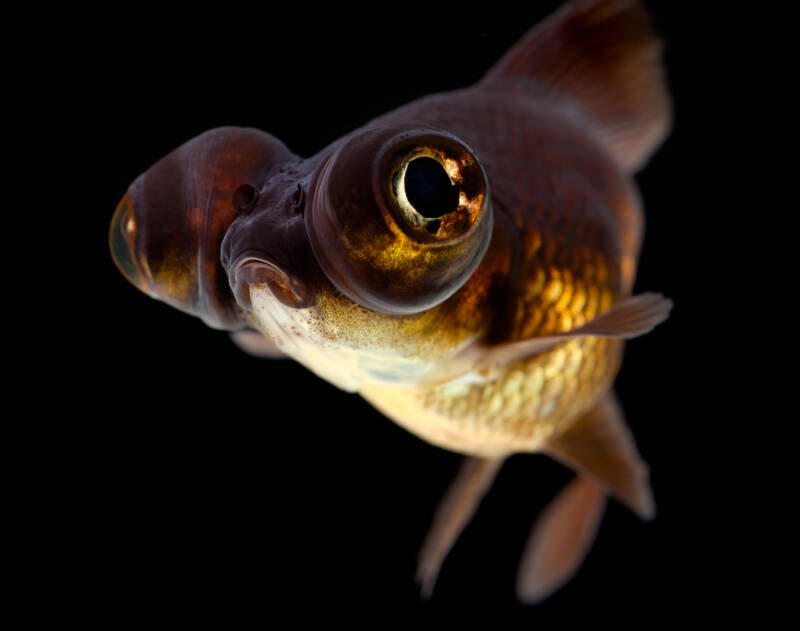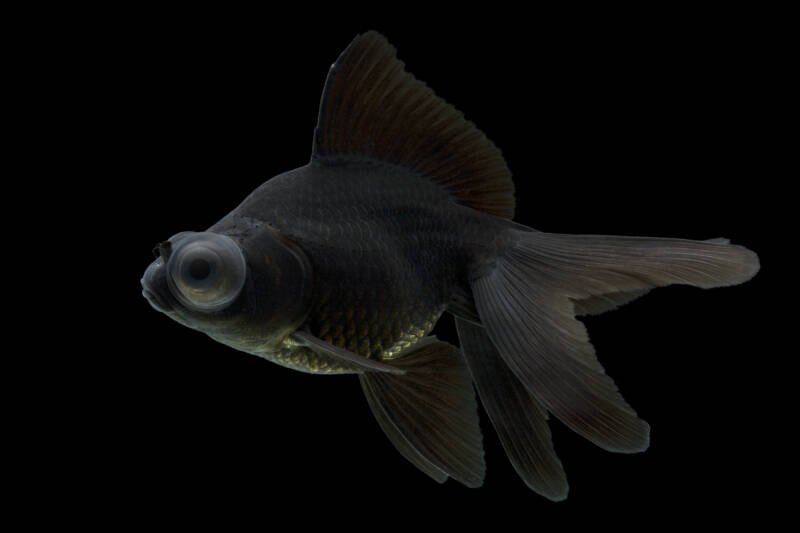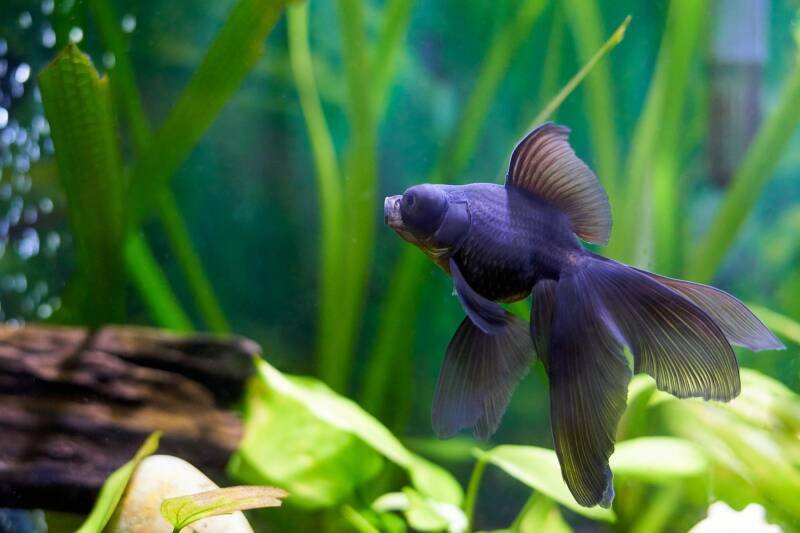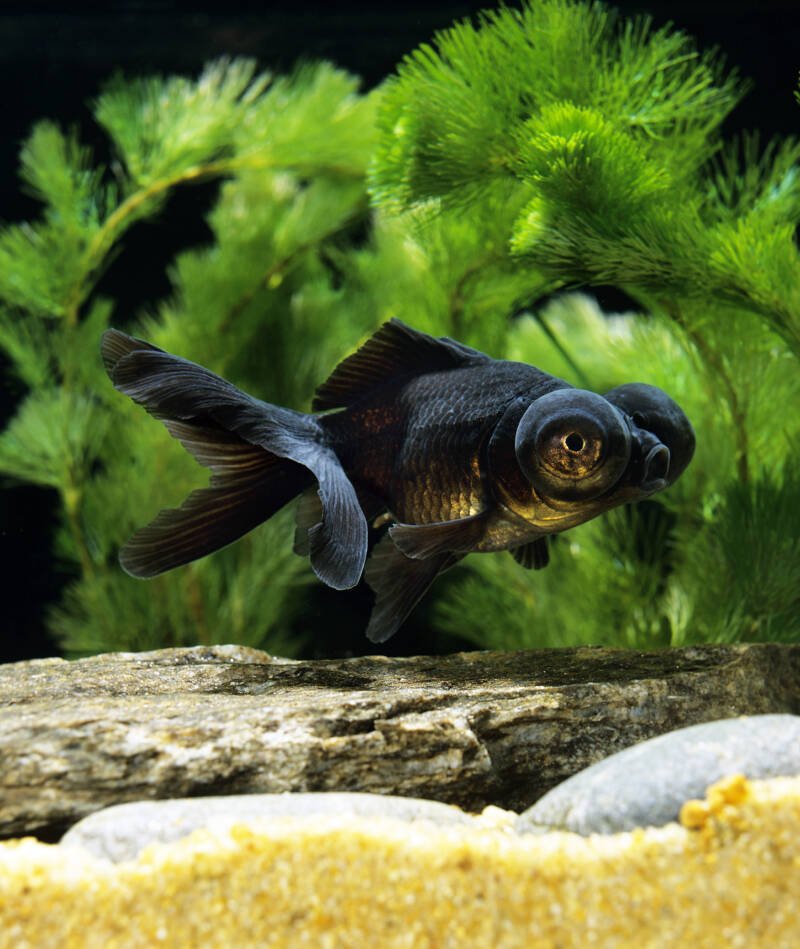When people think of large-eyed goldfish, it’s the telescope breed they’re referencing.
And there’s no more stunning variety than the black moor goldfish (Carassius auratus). With their distinct velvety color and dramatic eyes, they stand out-in the best way.

Members of the fancy goldfish group, black moors have rounded bodies and long, flowing fins.
But it’s those eyes that make them so popular with aquarists. Resulting from increased intraocular pressure, the bulging eyes are known as dragon eyes.
As with all telescope goldfish, the eyes grow with the fish. And while they stand out from the sides of the head, they provide feeble vision.
Black moors struggle to see the environment around them – and may suffer injury if you’re not careful with tank décor.
However, in general, black moor goldfish don’t require specialized care. So long as you provide a clean tank environment and a proper diet, they thrive. This makes them manageable for anyone – including beginners. And that adds to their appeal.
At a glance
| Tank Size: | 20 gallons (76 l) for one, 10 gallons (38 l) for each additional goldfish |
| School Size: | at least three |
| Temperature: | 50-75°F (10-24°C) |
| Lifespan: | 10-15 years |
| Size: | 6-8 inches (15-20 cm) |
| pH: | 6.5-7.5 |
| Hardness: | 5-19 dH |
| Ammonia: | 0 ppm |
| Nitrite: | 0 ppm |
| Nitrate: | 0 ppm |
In this article
In the “Wild”
As one of the fancy goldfish varieties, you won’t see black moors out in the wild. And with their poor eyesight and slow swimming speed, they’re not adapted to handle conditions in the natural world, anyway.
However, the goldfish breeds you find in collections today trace their ancestry back to the Asian carp (Cyprinus carpio). The two look nothing alike, but they share the exact tolerances for a wide range of water conditions.
Appearance
Black moor goldfish are a specific color variety of telescope goldfish. They get that deep black shade from an excess of melanin in their scales. It’s not a standard color found in fish, making this variety of goldfish coveted among aquarists.
Juvenile black moors DON’T start with that rich, velvety tone. Instead, they’re pale and grow darker over time.
And you may see additional color changes occur. It depends on the breeder as to whether or not your fish will stay dark or turn to something more surprising.
Bronze tone
Black moors with a “bronze” undertone will likely turn orange or red. (Often called red moors)

This can also happen if you keep your fish at too high of a temperature: warm water helps bring out warm tones in metallic varieties of goldfish.
Silver tone
If you want to ensure you have a genuine black moor, look for a white or silver tone along the belly.

These fish stand the greatest chance of NOT changing color when they get older. You can also keep your tank on the lower end of the temperature range.
Size
As with all goldfish breeds, black moor goldfish can grow to fill the available space you provide.
On average, they reach a length of around 6-8 inches (15-20 cm). However, if you open up their space, they may get larger.
Lifespan
Due to their hardy natures, it’s not surprising to find black moors surviving for ten or even 15 years.
And some aquarists have even managed to keep their unique telescopes alive for up to 20 years with superb care. With proper tank size and a healthy diet, they’ll stick with you.
Behavior
Black moor goldfish don’t achieve fast swimming speeds. They DON’T have streamlined bodies.
And since they struggle to see correctly, they startle easily. As such, they prefer to hang out in a school with one another for reassurance.
You shouldn’t keep less than three black moors together. This prevents stress from building up within your fish.
They’ll shoal together, rather than trying to duck into hiding among the tank décor. As sharp edges could damage their eyes, it’s best to avoid startle reflexes.
They ARE peaceful goldfish species. And if you want to keep them with similar slow-swimming members from the fancy goldfish group rather than a school, you can try.
But given the option? They’d rather stick with their own.
Unlike most goldfish species, black moors prefer to stay in the middle regions of the water column.
They aren’t as prone to digging around the substrate as others. This makes it easier to notice potential problems. (Hint: it’s a not good thing if you see a black moor on the bottom)
Tank Setup
While black moor goldfish have compact bodies, their fins fill the space around them. As such, you’ll need to account for the extra room.
You shouldn’t keep them on their own, but ONE black moor can fit in a 20-gallon (76 l) tank. For every fish added, you’ll need 10 gallons (38 l) more.
Most goldfish varieties handle tanks OR ponds without a problem. But black moors are an exception.
The water conditions aren’t the problem – it’s the outdoor environment. They can’t escape predators and quickly end up beautiful snacks.
It’s tempting to install bright lighting to show off that rich, black color, but skip it. While they can’t see well, black moors ARE sensitive to light.
Natural lighting works best for these bulging-eyed fish. You’ll protect their eyes if you skip the spotlights.
And, as you’d expect from a goldfish, you need to stay on top of your filter game. A canister filter works the best with these waste-production machines.
Failing to keep water conditions as pristine as possible will lead to color changes you DON’T want to see.
Water Conditions

Black moor goldfish tolerate a wide range of water temperatures: 50-75°F (10-24°C). Some people even skip bothering with a tank heater and stick to room temperature water. Or they integrate their black moors into tropical tanks as warm as 77°F (25°C).
And while these fish are remarkably flexible in their temperature demands, the problem comes with CHANGE.
If water temperatures go up or down too fast, they die. It’s one of the worst and most common causes of death for black moor goldfish.
If you DON’T use a heater or chiller, keep the aquarium away from direct sunlight, doors, windows, or vents. This will help the water remain as stable as possible.
Keeping a thermometer in the tank to help you monitor things will go a long way to protecting your fish.
Black moors will otherwise remain adaptable to their water conditions. A neutral pH between 6.5-7.5 and a hardness of 5-19 dH will do fine.
But make sure you keep everything pristine. They won’t tolerate ANY ammonia, nitrite, or nitrates! When black moor goldfish succumb to ammonia poisoning, they can change color. You may see a switch from black to gold.
Check your water quality immediately. It may be a natural change, but you don’t want to take that chance and miss a problem.
Decorating the Black Moor Tank

While some goldfish varieties with unique characteristics require a particular substrate, black moors aren’t that picky.
They don’t hang out around the bottom and aren’t the excavators other breeds are. You can get away with sand, gravel, or decorative marbles without a problem.
It’s the remainder of the décor you need to take care of. Sharp edges may pose a threat to their dragon eyes. Look at your rocks and driftwood carefully. While these natural items look attractive, you don’t want edges that may scrape those eyes.
Any time you have goldfish, it’s always a good idea to add live plants to your aquarium.
They offer places to hide, and they aid with removing waste from the water. Black moor goldfish are omnivores and may take some bites at them, but they won’t decimate them.
Some of your best plant options include:
- Anubias
- Bolbitis fern
- Crinum calamistratum
- Hornwort
- Java fern
- Marimo moss balls.
Black Moor Goldfish in Communities

Black moor goldfish are on the shy side. They do best in schools of their own. But as they tolerate water temperatures in such a wide range, you CAN mix them into communities without too much trouble – and that includes some tropical tanks.
Tank Mates
When you decide to create a community with black moors, look for fish on the slower side.
Fast swimmers will make them feel uneasy and look for a hiding place. Remember, they can’t see well, and high-speed blurs? Not ideal.
Some of the best tank mates for black moor goldfish have a similar temperament. This includes almost all of the other fancy goldfish. You’ll also end up with an attractive display if you combine them with:
- Angelfish
- Bristlenose plecostomus
- Cherry barbs
- Dwarf gouramis
- Glass catfish
- Kuhli loaches
- Mollies
- Neon tetras
- Otocinclus
- Other goldfish
- Zebra danios.
It sounds comical, but one of the best tanks to create is a “seeing-eye goldfish” tank.
You can combine black moors, telescopes, and celestial eyes together. None of them have excellent vision, making them ideal for pairing together.
And while they ARE omnivores, black moors don’t trouble invertebrates. This means you can create a mixed-species aquarium without a problem.
They get along well with any of the following species:
Incompatible Species
Due to their reserved nature, black moor goldfish don’t do well with aggressive, fast, or territorial tank mates.
You’d never put them with the majority of the cichlid family, for instance. And ANY fish with habits of nipping at fins? That’s a bad idea.
Food and Diet
Like all members of the goldfish species, black moors order from the omnivore menu.
This makes it easy to feed them. But it can also lead to problems if you’re not careful in WHAT you offer or how often you offer it.
Commercial foods are simple to track down and sprinkle on the top of a tank.
However, too much can lead to your fish developing constipation and sinking to the bottom of the tank. They need proper levels of fiber to help maintain a proper balance.
You can prevent constipation by making homemade fish foods, which mix proteins and vegetables.
Or you can split your feedings between the two so your fish receive the proper balance of nutrition they need.
Black moor goldfish may not see very well, but they don’t have a problem tracking down their favorite protein sources – whether live or frozen:
- Daphnia
- Bloodworms
- Brine shrimp
- Tubifex worms.
And you can break up the protein with healthy vegetables that bring in proper amounts of fiber. Broccoli, lettuce, and spinach do the trick nicely, and they’re easy to break into small pieces. Plus, black moors seem to like them.
You only need to feed your black moor goldfish twice a day. And they shouldn’t receive more than they can finish within a few minutes.
If you try to stuff them in a single feeding, they’ll end up struggling to digest the food and sink to the bottom.
Breeding Your Black Moor Goldfish: For Fun and Profit
Breeding black moor goldfish is easy – provided you have a male and a female. You’ll need a separate breeding tank to keep the parents from eating the fry. But otherwise, these aren’t difficult fish to get to spawn.
Males or Females?
Looking at black moors outside of spawning season won’t help you tell the guys from the girls.
They look almost identical. Males are a tiny bit smaller, but if you have fish that are of different ages? That may not help you.
During spawning season (April to August), males develop breeding tubercles. These are tiny white spots that appear along the pectoral fins. However, there’s a catch: they only show on MATURE males. Youngsters don’t produce them.
And then there’s a second catch: some FEMALES develop breeding tubercles! There won’t be as many, and they’re not as prominent, though.
And you’re female WILL plump up with eggs. So look at her from above to get your confirmation.
Spawning Conditions
Spawning in black moor goldfish follows the spring-summer weather change. You’ll want to mimic that by slowly increasing the water in your breeding tank by 3 degrees each day until you hit 75°F (24°C).
Black moors lay their eggs on flat surfaces. You can provide this by using a bare-bottom tank or adding in broken terracotta pots.
As the average female can lay up to TEN THOUSAND eggs, you’ll need plenty of room!
You’ll know you’re on the right track when you see the male swimming circles around the female in a courtship ritual.
Spawning can take several hours to complete. Once you see them finish, transfer the parents OUT of the tank, or they’ll decide to eat the eggs.
The fry take about a week to hatch. They’re capable of swimming right away, and they come out HUNGRY.
You should have fry foods with a high level of protein and iron to get that black color started. They’ll need two months before they can switch to adult foods and join the others.
Hardiness and Diseases
Overall, black moor goldfish have a hardy demeanor. If you stay on top of their water quality – and water temperature – they don’t develop too many problems. And, of course, you need to monitor that diet carefully.
However, those eyes are SO delicate. They can get caught on a net when you catch them or end up punctured or scratched by sharp objects within the tank. Once damaged, it takes no time for an infection to settle in place.
The compact body also presents concerns. As with other fancy goldfish varieties of this shape, they suffer from swim bladder disease. Unable to maintain buoyancy, they bounce at the top of the tank or sink to the bottom.
You may also see your black moors develop velvet disease. It’s crucial to look carefully any time you see spots or color changes. This is tricky as this breed CAN change color as a natural part of their growth!
Black Moor Goldfish: Are They For You?
Black moor goldfish range in cost from $5-$20. And in this case? Cost matters.
You don’t want to spend on the low end, as you’ll likely end up with a fish prone to health problems. And you could find yourself with one of those “orange” black moors down the road!
While it means spending a little more to fill your appropriate school, it’s better to go for higher quality.
Breeders that charge premium prices have also invested the time to ensure their goldfish come from healthier lines. You’ll end up happier in the long run.
And since you have OTHER health concerns to worry about (i.e., those eyes, their diet, and water quality), do you really want to start with a sickly fish, to begin with? Probably not. Better to splurge a little.
The Most Stunning of the Dragon Eyes
Black moor goldfish fascinate people. They have bulging eyes people associate with goldfish, set against rich, black scales.
And provided you keep up with healthy water and a quality diet, they’re not difficult to manage – for anyone. It makes them the perfect fancy goldfish!
Do you keep black moor goldfish?
Have you ever needed to manage a case of constipation? How’d you do it? What color changes have you noticed?
Share your questions and stories with us here!